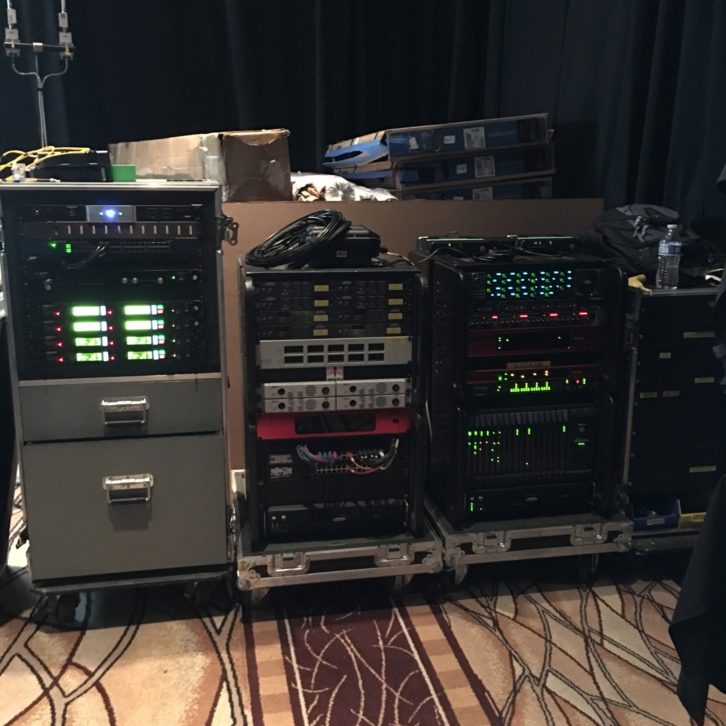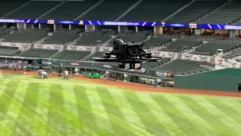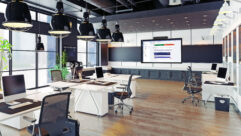 ESPN’s World Series of Poker pits thousands of the best players against each other and finally whittles it all down from four ballrooms to one table of nine. Televising it requires the ultimate in production communications with lots of RF gear. Soundtronics Wireless of Las Vegas made it all happen and Jason Waufle is here to tell us how they got it done.
ESPN’s World Series of Poker pits thousands of the best players against each other and finally whittles it all down from four ballrooms to one table of nine. Televising it requires the ultimate in production communications with lots of RF gear. Soundtronics Wireless of Las Vegas made it all happen and Jason Waufle is here to tell us how they got it done.
SVC: Tell us about Soundtronics Wireless. You have two offices I believe.
Jason Waufle: Yeah, Bennett. We have an office in Burbank, California that opened in 1964, purchased by Dave Bellamy in 1991. And then the Las Vegas office opened in 1991 as well.
OK, so what have you got going on?
Soundtronics Wireless is an RF provider for mostly entertainment broadcast and sports broadcast live events, so we handle the U.S. Open, the World Series of Poker, we do some NFL on Fox segments depending on when they take their desk show on the road. Showtime Boxing has been one of our largest clients for quite a while. That’s all the Las Vegas office. The L.A. office is a little more entertainment-based. They handled a lot of broadcast series from The Voice and American Idol, Dancing with the Stars, up to award shows like the Grammys and the Oscars. All RF packages, RF mics, IFBs and some PL communications depending on the show.
The World Series of Poker is a huge production. The show floor evolves as it goes on and the coverage would have to evolve along with it.
Yes, it’s very large. It starts with – I think this year there was over 7,800 players and about a $74 million prize pool. They start at the Rio All Suite Hotel and Casino in Vegas covering four ballrooms. We do about 16 days straight total with three of those days being set-up days. We use 35 RF belt packs, about 45 RF mics, six to eight IFBs, quite a bit of gear on that show. We get down to obviously nine players at the final table with one champion. We mic all the players at three featured tables, so there’s 27 microphones there. We mic all the dealers and the dealer IFBs. The communication side of things is pretty extensive. At the beginning when there’s 7,800 players, there’s hundreds of poker tables that are having live action. And so the goal for us is to try to be able to cover all those hundreds of tables. Obviously that’s a very difficult task. What we’ve done is set up what’s called poker spotters; people that know the game really well and know what to look for. And they’re on their own channel and they’re out amongst all these tables looking for exciting hands and looking for hands that could shape the tournament. Whenever they see something that’s potentially exciting, they call in to commando crews, which are groups of ENG-style shooting crews that we’ve tied into our main communication system with Freespeak units. These commando units can move fluidly through all four of the main ballrooms and to any table at any given time to cover any poker hand at any time throughout this entire tournament.
You would need to have a very versatile communication system for that so why was the Clear-Com Freespeak II system right for this?
There were a lot of reasons. First of all its flexibility in coverage and multiple frequency bands in the 2.4 and the 1.9 allows us to get up to that 35-36 belt pack count that we need to get this done. Secondly, it’s got massive included I/O in the cards that you put into the EHX frame. So I get 64 ports of MADI on a single card which is a lot of bang for the buck and allows us a ton of flexibility. This year we had 62 MADI channels that were bi-directional to and from the truck. The other thing was easy distribution. ClearCom’s integrated fiber splitters for their Freespeak deployment of antennas makes for really, really easy distribution of RF coverage area.
So there’s got to be some serious RF coordination going on; not just for this show but Las Vegas is a very active RF environment. So how do you manage to handle all the RF coordination?
Another reason why we choose Freespeak is because it’s up in the gigahertz range, which has allowed us a lot more space down the UHF spectrum for our microphones, our IFBs. The second thing is we go about a month ahead of time and do a site survey scan with the spectrum analyzer. We also touch base with any of the local theaters that are inside the Rio and make sure to update our list of their current active frequencies. We get in touch with Rio hotel and security. We get in touch with their events. We build a master list for pretty much the entire casino–shout out to the Rio for being as cooperative as they are. And then we start to work into what we’re going to add to that,. Luckily we have a pretty large inventory of wireless devices and ranges that allow us to pick the lowest noise floor TV channels that we can, start to coordinate frequencies a couple weeks ahead of time, and build the system out to give us the best possibility of success in the areas that we have found to be the cleanest. So it is quite a job. We are based in Vegas, so we know the Vegas spectrum really well. Our office is about, I don’t know, 10 blocks from the Rio so we’ve got an antenna on the rooftop of our office that we actively scan for new DTV stations or new noise in the valley. So it’s nice that the show is in our backyard, but it’s definitely a challenge. We use intermodulation analysis software from Professional Wireless to coordinate intermods, thirds, fifths, and to manage our frequencies.
What type of RF mics do you use?
For that show it’s actually entirely Shure products. This last year we used Shure Axient digitals for all the player mics—that’s 27 Axient digital player mics, plus or minus a couple spares, for the three main tables that are featured, nine players per table. We use Axient digitals for the dealer mics as well, so there’s another three mics there. And they actually double out so dealers have changes about every 45 minutes. So we mic Dealer A with one mic and we mic Dealer B with the second mic on all three tables. The dealers also wear Shure PSM 1000 in-ear monitors as IFBs. We just find the range and the diversity receiver that Shure has come up with to be more reliable. And then we use Shure Axient analog stick mics for our standup hosts, mainly for their frequency diversity and their agility and frequency-hopping that makes them essentially bulletproof. The reason we went with all Shure devices on this show was it’s really, really convenient when you’re working poker for 17 days in a row to have Wireless Workbench networked to all of these receivers. We bring in a 22-inch monitor that we connect to the computer and we put all our receivers and transmitters up on Wireless Workbench and it gives us a really central monitoring location to be able to quickly look at battery levels, signal strength, audio input metering, control frequencies, and control the Axient mics remotely with the access points they give. So Shure really knocked it out of the park for us to be able to streamline that much RF into one management software.
 That’s an enormous amount of wireless gear to look after and a very mobile and changing operation as the competition continues and the players are knocked off.
That’s an enormous amount of wireless gear to look after and a very mobile and changing operation as the competition continues and the players are knocked off.
The main goal is to make sure that the broadcast is seamless and nobody knows what’s going on behind the scenes. But you’re absolutely right. With the amount of tables that are shifting we get to the point where we start to lose entire ballrooms. Earlier I said we start with four ballrooms, and the focus is fluid. There are a couple of producers for the outside tables – the main tables – and a couple of producers for the inside main table. So Clear-Com has allowed us to give users two options. You can either give the end user on the belt pack a scroll list which allows them to manipulate by themselves what channels are on their belt pack in any heat of the moment, which is really, really handy for those savvy users that move a lot and understand how that works. And it’s pretty easy to teach. With a click of a menu button and a scroll you can change whatever PL channels are attached to your belt pack. And the EHX configuration software allows me to build those scroll lists and customize them for individual users. So effectively you can have 64 PLs on one belt pack. They say it’s a four-channel belt pack, but you can layer those buttons with multiple channels underneath. So as tables move and players change and the poker tournament evolves, that changes who certain people need to talk to. The biggest example I can think of is when we go down from three main tables to two. So all of the production staff that was on table three – the three camera operators, the jib operator, the stage manager, the A2 – they’re all now moving to work on the inside table or one of the outer tables that’s left. They can either change their belt pack themselves, or I can quickly go into EHX configuration software and update their belt pack live in a matter of seconds to allow their belt pack to switch over to whatever they need to be hearing and who they need to be talking to–it makes for a really quick smooth transition. And my favorite part is nobody’s ever waiting on me, you know? If somebody needs their PL changed it happens quick. They can do their job and no one is waiting on them.
How long did the whole system setup take and does anything unexpected ever come up that you just have to roll with the punches on?
Setup on site is about three days long; three full production days. We start about a month ahead of time at the office. As I mentioned earlier, we go down to the Rio and do a site survey, kind of check out what frequencies are in the air and maybe if anything has changed from the year prior. Then we get into building the system and the racks and going through our checks and balances at the office to make sure everything is functioning in the systems that we’ve built. We do our best to get ahead of belt pack names, individuals that are going to be there, channel counts. Anything that I can preprogram before we get onsite I do my best, so that when I arrive I’m as preprogrammed as possible. Once we got onsite, like I said, it was about a three-day setup. We did have an unexpected situation that happened this year that threw us for a little bit of a loop. We had a bit of a MADI card failure. It was a clocking issue, which a lot of your people that work in the tech side of broadcast are far too aware of. It was actually pretty interesting. It would be happy and functioning properly, have two-way communication between the ADAM frame MADI card and the Clear-Com EHX MADI card for about, I don’t know, 10 or 15 minutes and then that card would just fail. It was pretty intriguing because most MADI situations, when a card works it works and when a card doesn’t, it doesn’t. If the clock works, it works. So we had a shifting clock and we brought in a clock scope and plugged that in and watched the clock kind of start to fade, and then it would get so far out of sync that it would lose. To solve that we brought in ClearCom’s ProGrid MADI transport system that we had on our shelves at the office down the street. It’s a MADI transport over fiber system that reclocks MADI internally. So we put a ProGrid MADI at the truck site and a ProGrid MADI on the floor next to the EHX Eclipse frame, and reclocked the MADI through that and it solved that problem right up.
You’ve got to have a lot of rack mounted support gear to make all this work. Do you have all that in a production truck that pulls up to the building or do they provide space in another ballroom or closet for all of the rack gear?
There’s a production truck that pulls up for, obviously, the main broadcast side. It was a dome unit this year out of Canada. The truck comms are all RTS Adam frame with KP-32s inside the truck. Outside of the truck we run, obviously, the ProGrid MADI fiber solution which gives us 64 channels of MADI and that comes inside to the main ballroom – the Amazon ballroom at the Rio. We are actually set up right behind what is the World Series of Poker set that you’re seeing on TV. So right behind that we’ve got kind of a pipe-and-drape area in that ballroom that is our home base and that’s where we set up all of our IFB racks, mic racks, PL racks. It’s about a 20 x 15 square space. We’re there for – it’s actually a total of 22 days because we do another poker tournament immediately following that that we do live to tape. So it’s pretty much our home for the entire month. We set it up pretty nice to be honest.
We’ve talked about the Clear-Com Freespeak II digital wireless intercom. What’s the maximum number of belt packs that you can run per transceiver in each band? You’ve got two different bands you can run in.
Correct. Yeah, there’s the 2.4 gigahertz and the 1.9 gigahertz band that Freespeak offers. Clear-Com standards say you should run. 2.4 at five belt packs per node; 1.9 they say four. Generally, we take one off of that just to play it a little bit safer. We usually run about three to four per node and we run about four for the 2.4. And that’s just because of how the system works in terms of handing off from belt pack to belt pack and from node to node. So your hope is that you try to keep at least one lane open – I call it a lane – one allocation open per transceiver at all times. And what that does it that allows for the smoothest transition from belt pack to antenna as belt packs move around.
And on the transceivers I think you run Cat5 or Cat6 to those?
Yeah, that’s correct. So the transceivers themselves, we run Cat6. You can run Cat5, it’s just a little bit more shielding. And they’ll power over Ethernet if you’re coming post-splitter. If you’re not coming post-splitter off of a frame you’ve got to power the transceivers locally with the Clear-Com power supply. So we use splitters in all of our distribution. The splitters themselves are one-in and five-out and that one-in can be either fiber or Cat5 depending on what solution you’re looking for. And then once you get to the end point, you run five antennas off of that and that’s all over Cat6 and all powered from the splitter over the Cat6.
That’s a lot of transceivers to be located in various places and I guess stuck on walls or on stands or ceilings?
Yeah, yeah. We get a little bit creative sometimes at World Series of Poker where we play stuff. We actually tape transceivers to the back of the set, and then the rest of them are mostly on stands or clamped on trussing throughout the four other ballrooms. That’s pretty much what the three days of setup are for; getting 20 transceivers up amongst the four ballrooms can be pretty time-consuming and you want this stuff to be semi-permanently installed and run very cleanly because there’s going to be a lot of action and a lot of time that it’s going to be there. So we have a variety of clamps that we have at the office that we use so that we can mount things in multiple areas, but yeah, a mixture of stands and clamps and a little bit of crafty tape jobs sometimes gets our antennas where they need to be.
And one of the things that makes the Freespeak II system so good for this is the features that the belt pack users have.
Yeah. We had talked about scroll lists, which is one of my favorite options. And again that’s where you can layer one button with multiple PLs underneath it, and you can do that on all four of the buttons. So on Poker we’ve got four different camera calls: the camera for the main table, the camera for outer 1, camera for outer 2, and then camera call for the commando unit. So if you’re one of six roving RF cameras, you never know where you’re going to be shooting at any given moment. So we create a scroll list for those camera operators where they can change their belt pack to be either on the commando call or on the outer table 1 call or on the main table call whenever they need to get there and whenever they’re shooting at that particular location. There’s another PL designated for all cams and that’s just for the directors to get on and say, “Hey, camera 6, I need you at X,” wherever it may be. So they can hear that call at all times, they then can transition to that location and they can change their belt pack over to be at whatever channel they need at any given time and it works really well.
Yeah, something with those features would be essential because of the way that the com setup has to change as the show goes on.
Absolutely. It is a living, breathing show for sure. There’s days where we only lose a small percentage of players and then there’s certain days where we lose three or four times as many as we expected that day. So as we lose players we lose rooms, we lose locations, we lose tables, and everything’s got to be moving and be very fluid. Clear-Com allows us to be as flexible as this show demands. Outside of the scroll lists, as I mentioned before, I can update things live. Every belt pack change I do is instantly changed on the belt pack when you’re in live mode on the control software. So if I get a note from a producer through the PL, “Hey, I need to talk to this guy right now,” I can pull up their belt pack, I can see that maybe they don’t have that functionality ahead of time, and I can program it in there immediately and let that producer know, “Hey, you can talk to them. Fire away.” And it’s a matter of seconds.
Well, the equipment is great but there’s no substitute for experience in handling that particular production. You probably learn some things every time you do it so are there any changes in the setup or operation planned for the next World Series of Poker?
Absolutely, every year. Like I said, we’ve been doing this for at least six or seven years now. Obviously, we plan on bringing the ProGrid MADI to start next year. I think most every show now that I know I’m going to be using MADI transport on to connect to an Adam frame or to another frame and rely heavily on MADI. I’m going to put a Clear-Com ProGrid MADI in. Moving into next year that will be built into our package. I think we learned a little bit about transceiver location and some better cabling paths that we could do. We learn that every year. And then a really cool thing we did this last year was we ran all of the IFBs for our dealers and our talent through the MADI. And so the IFB sends from the truck, hits my Clear-Com frame on the floor and then I exported those out of an analog patch bank to the PSM 1000s to hit the actual transmitters. That allows me to put IFB interrupt on my A2 Freespeak belt packs, so they can interrupt dealer IFB or talent IFB straight from their hip. Or occasionally you’ve got an issue with a dealer or something happens- -things always happen–and maybe you need to get ahold of that dealer at the table as an A2 or even as a stage manager without bothering the producer in the truck. They can interrupt the IFB straight from their belt pack and get a message to the table without having to interrupt the broadcast. And that’s really what communications is about for us is making sure that everybody can communicate to anybody they need to at any time.
What other projects are coming up for Soundtronics Wireless?
Oh, boy. Let’s see, I fly out tomorrow for the NFL on Fox Special from Fort Benning in Atlanta, Georgia. That will be quite the Freespeak installation as well. I think we’ve got 25 1.9 belt packs, and Eclipse frame on that. That’s upwards of 45 wireless as well. A pretty large show we do for Fox every year. We do all of Showtime boxing. We’ve started a new boxing circuit for Belmonte and a company called DAZN, which has taken over some of HBO’s boxing. We’ll do the NFC Championship early next year. And then we’re a dayto-day rental house, so we’re moving gear in and out every day for people that are local that need it or shipping. So we stay pretty busy. We’ve got 10 employees in Vegas and I think 11 or 12 in L.A. So we’re growing and trying not to grow too fast.









